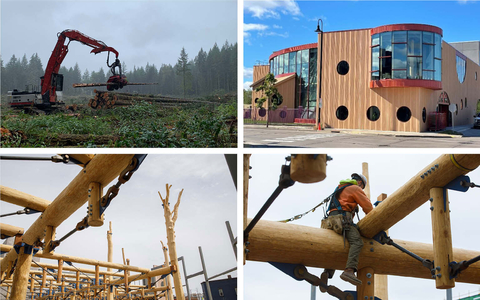Children’s Museum of Eau Claire First-of-its-Kind Design Showcases Most Innovative Use of Carbon-Smart, Mass Timber Product
Commercial timber construction has been raised to new heights with the first-of-its-kind Structural Round Timber (SRT) building, the Children’s Museum of Eau Claire (CMEC).
This press release features multimedia. View the full release here: https://www.businesswire.com/news/home/20221031005194/en/

(Clockwise from top left): 1) Structural Round Timber donated from Port Blakely harvested from longer rotation forests provide optimal carbon sequestration from carbon-smart forests. Port Blakely is a family-owned timber company with 145,000 acres of sustainably managed forest in Oregon and Washington, including the 10,000-acre Winston Creek Certified Carbon Forest; 2) Image of the nearly completed museum, Steinberg Hart; 3) Structural Round Timber trusses getting installed at the Children’s Museum of Eau Claire by local steel installation contractors; 4) 30’ Maple columns donated by Seven Islands Land Company demonstrate the majesty of timber structure and tower over first floor Port Blakely Douglas fir trusses. For hi-res versions of these and other images, contact info@WholeTrees.com (Photo: Business Wire)
The project was realized by visionary Architectural, Engineering and Construction (AEC) leaders across the country in close partnership with WholeTrees Structures, a woman-owned national timber products company whose mission is to improve the economic viability between healthy-managed forests and their rural communities. The primary structural support system for the new two-story museum consists of responsibly sourced mass timber, with round-timber columns, joist trusses and girder trusses used in place of conventional steel and concrete. This innovative usage demonstrates the multi-story potential of Structural Round Timber (SRT), the original – and perhaps the most sustainable and biophilic – mass timber product on the market.
Designed by internationally recognized architecture firm Steinberg Hart, the 24,000 square-foot museum features a loft-like interior space where round-timber columns act as an armature for hands-on exhibits and interactive technology to stimulate the imaginations of young people. Together with KPFF, one of the nation’s leading timber engineering firms, forest products companies and fabricators, the design team created a stunning carbon-neutral museum that will foster excitement, encourage play, and inspire discovery for kids of all ages.
Central to the museum’s design is the shared vision for sustainability of three key team members: Michael McHorney, the Executive Director of the Children’s Museum of Eau Claire, Steinberg Hart Partner and lead architect Malcolm Holzman, and WholeTrees Structures CEO Amelia Baxter.
“Working with WholeTrees and their partners is helping us deliver on a key goal of this project, to reduce the carbon footprint for construction,” shares McHorney. “As a result, the Children’s Museum of Eau Claire has sequestered more than 350,000 lbs. of CO2 equivalent in the timber structural system.”
Holzman states, “It is a delight to see reclaimed trees embodying the familiar, while making recognizable how a building is supported. A complex system, usually invisible, is now understandable for museum visitors.”
The story of the timber sourcing for this project is as innovative as the museum itself. Madison-based WholeTrees Structures brought to the project Port Blakely, a Pacific Northwest, family-owned renewable forest products company. They provided Douglas fir logs with verifiable traceability from the company’s single-origin Sustainable Forestry Initiative (SFI)-certified forests. Seven Islands Land Company, who manages 820,000 acres of SFI and FSC certified timberland owned by the Pingree Family in northern and western Maine, provided the 30’ structural Maple Columns for the project.
“The Port Blakely origin story is a perfect fit for WholeTrees,” says Baxter. “We work with architects and builders who are looking for products that are not only high functioning, but also have a strong sustainability story to tell in and of themselves. Now the Children’s Museum demonstrates how visually stunning carbon-smart design and construction can be.”
“Stewardship is at our company’s core and we’re excited to expand the impact of our Winston Creek Carbon Forest by partnering with WholeTrees to introduce new premium timber products to a growing market,” said Mike Warjone, President of Port Blakely US Forestry. “While all wood products have intrinsic carbon benefit, we believe our long-term view and forest management practices result in more beautiful, higher-quality structural timber products, and the added benefit is that the forest sequesters significantly more carbon, making it a perfect natural carbon solution.”
“This project will showcase the stewardship role that renewable forest products and carbon-smart building products can play in transforming our built environment and our relationship to our natural resources,” explains Baxter. WholeTrees provides an incentive for healthy forest management by taking what would otherwise receive less than optimal market values and transforms it into SRT – the highest value available to timber removed from well-managed forests.
According to Baxter, mass timber’s influence on the built environment continues to grow in North America, largely because its advocates in the AEC community pair mass timber’s persuasive carbon sequestration story with the positive impacts of these new markets on the forest ecosystems and economies that produce the products. In the case of Port Blakely, those impacts stem from the additive net carbon sequestration that results from longer rotations and the long-term carbon storage solution offered by modern buildings. As the AEC community gains a deeper understanding of how its procurement decisions can influence forest management practices, it has begun seeking products with “origin stories” that align well with their own priorities around issues such as sustainability and climate change. The two-story structure of the Children’s Museum of Eau Claire proves that the AEC community can now do more with carbon-smart building products from known forestry resources.
The Children’s Museum of Eau Claire is anticipated to open in January of 2023.
Key Links
WholeTrees Structures
Port Blakely
Seven Islands Land Company
American Carbon Registry (link to IFM certification)
Wood buildings and climate change
Project Facts
- World’s first two-story SRT Building of its kind
- 24,000 sq ft total museum
- (27) 15’ Columns
- (6) 30’ Ash and Sugar Maple Columns
- 33 Girders & 94 Joists
- 230 Douglas-fir logs from Port Blakely’s Carbon Forest Project
- Truss Carrying Capacity exceeds 1,300 lb/ft
- Sequesters ~175 tCO2e of carbon
- Timber Engineer: KPFF | Truss Fabricator: Building Products Inc | Engineer of Record: Ericksen Roed Assoc. | Architect: Steinburg Hart | General Contractors: Market & Johnson and Hoeft Builders
View source version on businesswire.com: https://www.businesswire.com/news/home/20221031005194/en/



